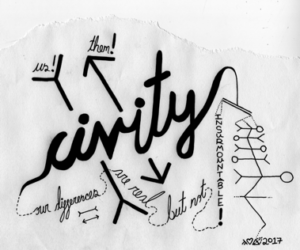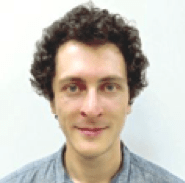By Daniel Friedman for EDRBlog.org

Successful environmental dispute resolution (EDR) requires long-term cooperation among stakeholders, who often have incongruent values and interests and may have experienced complicated previous interaction. EDR also often involves integration across disciplinary fields, ranging from mathematical ecology to history and law. As a result, EDR situations are “complex,” maybe even “messy.” We can learn a lot about how to navigate messy and complex systems from the field of Complexity science. In this piece, I consider the connections between EDR and Complexity science, and discuss how the notion of “Civity” can act as a bridge between Complexity science and EDR.
Complexity science is a powerful interdisciplinary framework for understanding complex systems such as the brain, ant colonies, and human societies. These systems all consist of many diverse subunits, evolve through time in non-linear ways, and exchange matter and information with their surroundings. Complexity science is less of a discipline, and more a way of identifying and working with organizational patterns that appear across systems. Beyond statistical or mathematical studies, Complexity science has been applied to questions of policy (Mitchell 2009), governance (Duit & Galaz 2008), and sociology (Page 2015), using both quantitative and qualitative models.
Civity is a national action-oriented initiative that draws on a Complexity science understanding of the social world (Strand 2014) to promote a culture where meaningful relationships are built on respect for others who are different. Civity highlights the fact that we create culture as well as experience it. The Civity initiative provides trainings to small cohorts of individuals, as well as a podcast and newsletter discussing these issues. Both Civity and Complexity science stress the importance of network-thinking, feedback loops across multiple system levels, and the impact of local behavior and connections on global outcomes.
Get notified when new articles are posted to the EDR blog – sign up for our email list »
While I belive Complexity science and Civity have much to offer EDR, I want to particularly focus on two key insights. First, network models from Complexity science can help us understand and influence EDR situations. Second, simple rules can lead to complicated socio-ecological outcomes, and we can understand this unfolding using the tools of Complexity science.
- Network models from Complexity science can help us understand and influence EDR situations. Complex systems are often visualized as graphs consisting of individual “nodes,” and relationships between these nodes. Complexity science relies on these visualizations to illustrate and provide intuituion about system function. Such graphical representations, or network models, can be useful for making sense of EDR situations. Dena Marshall shows this in her EDR Blog post on conflict mapping, in which nodes represent different stakeholders and edges between nodes represent relationships or influences.
Further, complexity scence tells us that when individuals act locally in complex systems (such as human society or ant colonies), their actions are amplified by the pre-existing network structure of the system. Certain network motifs (recurring local patterns of connectivity) are self-stabilizing, or robust to external changes. Other network motifs are destabilizing, meaning that they can drastically alter the dynamics of the whole system when prodded slightly. Graphical models in Complexity science are used qualitatively to summarize the essence of a complex system, and also used quantitatively to predict the impact of specific perturbations. Through mapping conflict situations and considering the robustness of network motifs, EDR professionals may be able to better understand complex dynamics and opportunities to influence the situation in a positive direction.
Civity takes this lesson about network models from Complexity science and aims to create authentic links between individuals from different groups. Improved ties between even a few individuals of different groups can radically improve the overall cohesion of the groups via increased information transfer or stereotype dismissal. This same approach seems key to effective EDR.
- Simple rules and small changes lead to complicated socio-ecological outcomes. In complex systems, it is commonly seen that simple “rules” of individuals (e.g. cars slow down when they see a car slow down in front of them) can result in complicated collective outcomes (e.g. a shockwave traffic jam). This is well illustrated by the ongoing current Calfornia water crisis, in which the single rule of “reasonable use” (Gray 2015) has proven rather problematic in its implications. Resolving the ambiguities and contradictions hidden within the word “reasonable” calls for transformational changes on ecological, legal, and sociological fronts (see Mount et al. 2017 for some ideas about what kind of changes might be needed).
Civity is concerned with how small changes in the social and behavioral ruleset of individuals in society can lead to benefits for the whole group. The kinds of interpersonal changes that Civity aims to affect in individuals from different groups are similar to those addressed in Jim Ferrell’s EDR blog post discussing conflict mediation in the Middle East.
Complexity science uses simulations to study how simple rules and small changes lead to complex outcomes—for example, how slight changes in policy affect larger changes in ecosystem sustainability. In one kind of simulation, known as an “agent based model,” rules for agents are specified, but system outcomes are not. For example, one might study the decentralized construction of an ant nest by simulating digital ant worker-agents with the rule “pick up dirt sometimes, and be more likely to put it down near other dirt,” then determining which mathematical values of “sometimes” and “more likely” will allow for the construction of a nest.
EDR deals with the problem of determining the small set of simple rules that will unfold and interact with the world such that stakeholders are content and the environment is healthy. It would be interesting to see whether agent-based models could help groups of stakeholders working together to generate solutions to environmental conflicts and challenges work together to make big positive changes.
EDR is the applied work of finding solutions to complicated socio-ecological problems. Complexity science and Civity are working on closely related problems about system function. These three areas of work and study have much in common, from similar ways of visually abstracting complex systems, to having similar core principles. I look forward to the learning that might occur on all sides if EDR, Civity, and Complexity science were to consider the unique teachings and perspectives that each field has to offer.
Thanks to Palma Strand for the helpful edits and discussions about Civity.
 Daniel Friedman is an organizer of the Stanford Complexity Group. He is currently a PhD student in Biology at Stanford University, studying the genetics of collective behavior in red harvester ants. His work can be found at danielarifriedman.com.
Daniel Friedman is an organizer of the Stanford Complexity Group. He is currently a PhD student in Biology at Stanford University, studying the genetics of collective behavior in red harvester ants. His work can be found at danielarifriedman.com.
